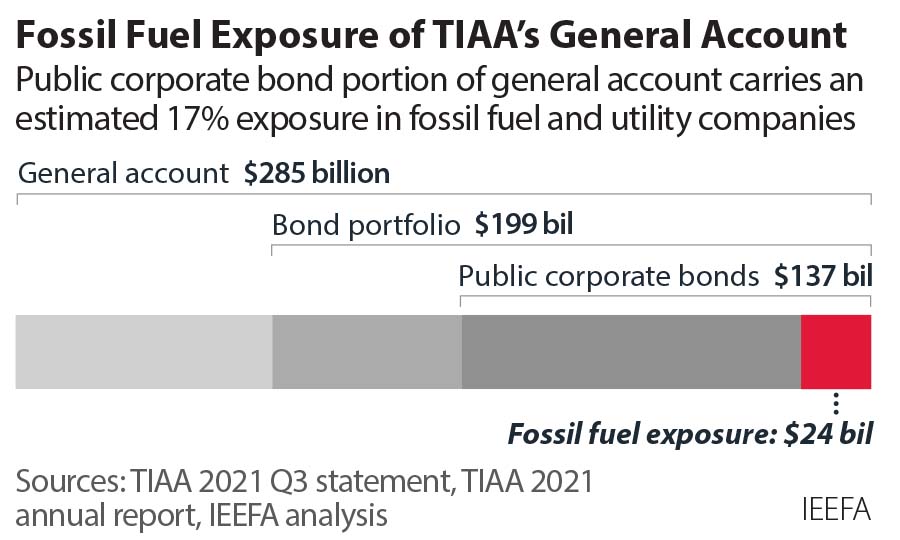TIAA has a long way to go to become a climate leader
The climate action plan issued by the Teachers Insurance and Annuity Association of America (TIAA) displays disappointing ambition and is misaligned with industry standards and appeals from its climate-aware customer base, according to a new Institute for Energy Economics and Financial Analysis (IEEFA) report, TIAA Fails Clients on Climate.
In late 2021, TIAA and its investment manager Nuveen issued a Climate Action Plan (CAP). The plan is modest and disappointing—with at minimum $78 billion invested in fossil fuels, TIAA has a long way to go to become a climate leader.
The main findings of the analysis include:
- The first phase of the Climate Action Plan covers TIAA’s $285 billion General Account. TIAA’s corporate bond portfolio and real estate holdings in the General Account are considered the first priority investments. They constitute $136.5 billion and $3.4 billion of the General Account, respectively. This $140 billion constitutes 10% of the TIAA’s total $1.4 trillion assets under management, a small, unambitious priority.
- IEEFA conservatively estimates that TIAA’s enterprise-wide portfolio of $1.4 trillion contains $78 billion in fossil fuel risks. The finding is heavily qualified due to a lack of transparency. TIAA should use the CAP process to address this opaqueness in the future.
- TIAA’s public corporate bond portfolio is heavily weighted with fossil fuels. A review of its $136.5 billion corporate bond portfolio in its General Account finds that the corporate bond portfolio carries an estimated 17.2% exposure to fossil fuel and utility companies.
- IEEFA estimates that approximately 12%, or $4.7 billion of the $34.1 billion General Account private equity portfolio has significant carbon exposure. TIAA’s private equity investments, currently called “other investments” and ranked a “low priority” for climate action, should be a much higher priority. The portfolio contains fossil fuel companies and financiers that have generated worldwide controversy due to their fossil fuel holdings. TIAA can bring an end to that outmoded legacy. Full disclosure of the holdings would be pathbreaking and consistent with TIAA’s professed commitment to leadership on transparency.
- The $10.1 billion in stocks in the General Account is a miniscule portion of TIAA-Nuveen’s vast holdings. However, these holdings are structured by an investment policy that covers the total estimated $501 billion in equity holdings, and therefore have much larger implications. IEEFA estimates that approximately 7% of the equity portfolio is exposed to fossil fuels. The first installment on TIAA-Nuveen’s Climate Action Plan is an opportunity to signal its longer-term perspective on fossil fuels. Even to bring this small portion into net-zero alignment, TIAA must consider major reforms to its individual and institutional customers. Will TIAA offer fossil free or decarbonized alternatives, or maintain its commitment to the losing proposition of fossil fuel equities?

TIAA’s failure to fully consider divestment as a mechanism to protect its portfolio is a striking lapse in its fiduciary obligations. TIAA has made it clear that climate risk is financial risk. The company’s failure to consider taking a strong defensive step and divest its fossil fuel holdings to clear its portfolio of the risk is logically inconsistent, financially imprudent and strategically unsound. It is difficult to see how its Climate Action Plan can meet its net zero goals without a clear, policy-based use of the divestment option.
Serving a customer base of educational, cultural, health and social service professionals who are knowledgeable about the dangers of fossil fuels and alarmed by rapidly accelerating global climate change, TIAA is well-positioned to undertake much more significant leadership on sustainable investing.
The company claims its climate plan will eventually address its enterprise-wide $1.4 trillion portfolio of bonds, real estate, private equity and stocks. Its portfolio has been shaped by its legacy as an insurance company. The legacy leaves it with a portfolio weighted heavily in fixed income investments (bonds). To balance out the bond market, TIAA and its principal subsidiary Nuveen developed a private equity portfolio that adds higher returns and greater risk. The company’s substantial real estate portfolio is innovative when it comes to implementing climate initiatives, but it falls short in many other asset areas.